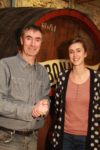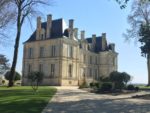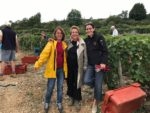Let’s go together to meet one of the most endearing family wine estates producing Armagnac
Château Garreau is a property of the Landes, producer of Armagnac and Floc de Gascogne. The property covers 85 hectares of which 27 hectares of vines are planted in a terroir of tawny sands. The rest of the estate is occupied by forests and ponds. Each year Château Garreau distills around 150 hectoliters of pure alcohol (i.e. 300 hectoliters of Armagnac) and produces around 30,000 bottles of Floc de Gascogne (red and white). The production of Armagnac is divided into four main cuvées: VSOP, XO, Cuvée du Siècle Extra, Cuvée Royale then vintages. The estate also has a production of Blanche d´Armagnac.
The estate was built in several stages, but from the 17th century there has been a production of Armagnac combined with polycultural agriculture. The property specialized in the production of Armagnac only in the 19th century when it was bought by a Russian Prince. As an anecdote, he arrived here because he married a young lady from a family from Labastide-d’Armagnac, a village located less than 5 minutes from here. They had met in Paris in the fashionable salons of the time. After some research it was found that he was affiliated with the Russian Royal family at the time. It was he who launched the construction of the underground cellar, unique in Armagnac.
It was in 1919 that Château Garreau was bought by the Garreau family.
Today the Garreau family manages the property expertly. Mr. Caillaud mainly deals with distillation and Mrs. (Carole Garreau) with marketing and promotion. They are assisted on a daily basis by a cellar master, Mr Demoura. Let’s go together to meet them
Why make Armagnac ?
“We specialize in the production of Armagnac and Floc de Gascogne. Strictly speaking, we do not produce wines on the estate because we are not equipped in the cellar for wine making.
Producing Armagnac is also a question of tradition. The estate has produced it for over 300 years and my family has distilled it for 100 years. We are well acquainted with the universe of spirits which in our view has a future. We prefer to confine ourselves to an area where we believe we know how to do well rather than to embark on an area that we do not know as well.
The property has long been managed by my father and my two uncles but in 2006 I made the choice, with my husband, to return to my land to take over the family estate.
Initially, I had no plans to take over the estate. I first studied at Sciences Po Bordeaux and then at the National Institute of Territorial Studies. This led me to start my active career as a senior manager as a local territorial authority.
So it was in 2006 that the question of taking over the estate arose, my uncle wanted to retire, and my father asked me if I was interested. The draw of the estate was stronger. We did not want to sell but to continue the adventure. So we started to take care of it in addition to our job. It was difficult at first to juggle the activities. I remember that during our vacations we would go to China or other countries to explore the markets. We have been living here for 5 years now, and full time! ”
Where does the name of the property come from?
“This is the name of the family. Before, the domain was called Domaine de Gayrosse, like the locality where we are. We do not know the origin of this name, nor its meaning. It was in the 1970s that my uncle got permission to rename the property with the word « Château ». ”
What type of terroir do you have?
“We are in the best area of Armagnac, at the heart of the terroir of tawny sands and sandy loam also with iron oxides. We find these beautiful ocher colors in particular on our plots! Iron oxide brings a very special flavor to our Armagnacs. We consider that this is part of the great vintages, on condition of knowing how to work them of course!
In terms of terroir, we are particularly favored, lucky on the Château Garreau. Everything is fairly homogeneous even though there are some variations on the plots. However, the latter are more intended for the production of our Floc de Gascogne.
Another of our particularities is that the vineyard is mainly planted with Baco. It is a grape variety that is fully expressed in our terroirs! ”
What is the signature of your production? What makes them recognizable by blind tasting?
“We have several clients who tell us that they recognize our armagnacs because they have a signature. I think it is aromatically linked to Baco (70-80% in our Armagnacs) with a little bit of Folle-Blanche and Ugni Blanc to increase complexity. Our Armagnacs offer a ripe fruit and candied fruit side that marries well with food, a smooth side with texture as well as a nice « fat ». Our Armagnacs are not dry in the mouth.
We distill at between 55 and 60 degrees, it depends on the year. There are no strict rules, we adapt the distillation to the characteristics of the distillation wine in order to obtain the best possible quality. Sometimes it’s 55/56 degrees, and other years it’s higher because the vintage lends itself to it. Our goal is to have consistent quality, to always get the best from our grapes. We have our own copper still which dates from 1919. My uncle perfected it by adding a few pipes at the outlets, heads and tails. It allows us to have more finesse in the settings. It’s a gas still.
We are officially at the origins of the first Flocs de Gascogne. My uncle produced the first hectoliters in 1974. We produce a white and slightly sweet Floc. We are going to blend 3 grape varieties and some years 4: Ugni blanc, Colombard, Gros Manseng and Sauvignon Blanc. The small proportion of Gros Manseng will bring us a little sweetness but we limit that because we don’t want to get too close to sweet or sweet wines. We want our Floc Blanc to be fruity but less sweet than the average Floc Blanc.
Regarding our production of Red Floc, we will use our traditional red grape varieties (Merlot, Cabernet Franc). In terms of tasting, we will find notes of blackcurrant and raspberry. ”
Do you have any plans for Château Garreau?
“Yes we have plenty but after all it is a question of timing and finance. Regarding the management of our vineyard, we are in HVE (Hight Environmental Value). Respect for our ecosystem, our land and those who work there are values that we want to continue to grow and support. We try to improve our equipment every day, whether it is working the soil or the vines. Regarding the winery, we would like to build a new one in the near future, more modern and with more room to work.
We have the Armagnac Ecomuseum on site, but we wanted to go further in our tourist offerings. This is why at the end of the year we are going to inaugurate an Escape Game on the estate … and of course around the world of Armagnac!
In terms of products, we have a permanent range, but every year we try to bring out a special cuvée that will only be sold for one year. We really want it to be special. This year we called it “100 (plays on words in french : 100 sounds « without »in french Prohibition”. It is a nod to the 100 year anniversary of prohibition. It offers woody, smoky and slightly peaty notes on tasting. It comes from a blend of eaux-de-vie that are between 7-12 years old. The idea behind it is to bring whiskey lovers back to Armagnac especially as an aperitif … Armagnac suffers, wrongly, from an image that sticks to its skin as a digestive but there are nevertheless so many other possible tasting moments. In 2021 we will certainly be making a « Brut de Fût » (original cask), plot-based and 100% folle blanche. It is not too usual for the house to produce a single varietal Armagnac, but it depends on our ideas, our tastings of the barrels. ”
Thanks to the Garreau family for the welcome




